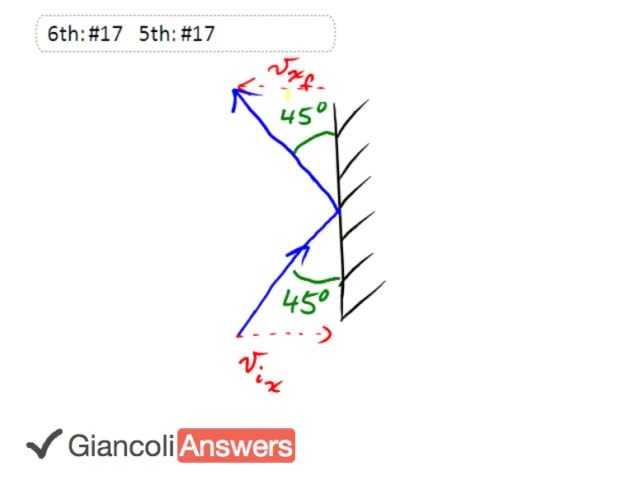

In order to watch this solution you need to have a subscription.
We have a ball approaching a wall at forty five degrees and it bounces off with the same angle and the same speed and so this means that the vertical or the Y-components of velocity are the same in both cases so say the Y-components of the initial velocity equals the Y-component of the final velocity. So if you take the blue arrow as being the velocity vector if you draw the Y-component here in the initial case ‘vy’ initial and the final case here the Y-component would still be the same because it’s the same speed with the same angle. And the X-components are also the same magnitude but they are different directions and the different directions is what’s important for the change in momentum. So algebraically: ‘vxi’ is the negative of ‘vxf’. So since the Y-components are exactly the same in both cases the change in momentum is going to be just the change in momentum of the x in the X direction. That equals ‘m’ times ‘vxf’ minus ‘m’ times ‘vxi’ which is negative ‘m’ ‘vxi' minus ‘m’ times ‘vxi’ where we made a substitution for ‘vxf’ and said that it’s negative ‘vxi’. And from that we can see that the impulse then is going to be negative two times ‘m’ times ‘vxi’. So this ‘m’ times ‘vxi’ is the initial velocity times sine forty five. You can tell from the picture the blue arrow inclining to the wall being the initial velocity vector and sine forty five giving you the opposite component of that triangle. So we make that substitution into the impulse formula for ‘vxi’ and then we’ll write: the impulse is negative two ‘m’ times ‘v’ sine forty five and then substituting in numbers we have negative two times zero point zero six kilograms times twenty five meters per second times sine forty five and this gives negative two point one kilogram meters per second.
Hi abryant59,
Thanks for the comment. Without seeing the exact problem on mastering physics, it's a bit hard to tell why they wanted a positive. Assuming there's no typo, it would mean their initial velocity is negative. The change in momentum is in the opposite direction to the initial velocity, so it will have the opposite sign.
If they have an initially positive velocity, then you are the luck discoverer of a typo.
The answer that I typed in to mastering physics was -2.5, based on this formula. The answer they wanted was 2.5.
You are the only reason I'm passing physics, I love you, keep up the good work!!
Hi Kaia,
I'm glad the videos are helping! Thanks a lot for the good wishes. If you don't mind me saying, please tell your physics teacher how you feel so that he signs Southport up again next year :)
All the best,
Mr. Dychko